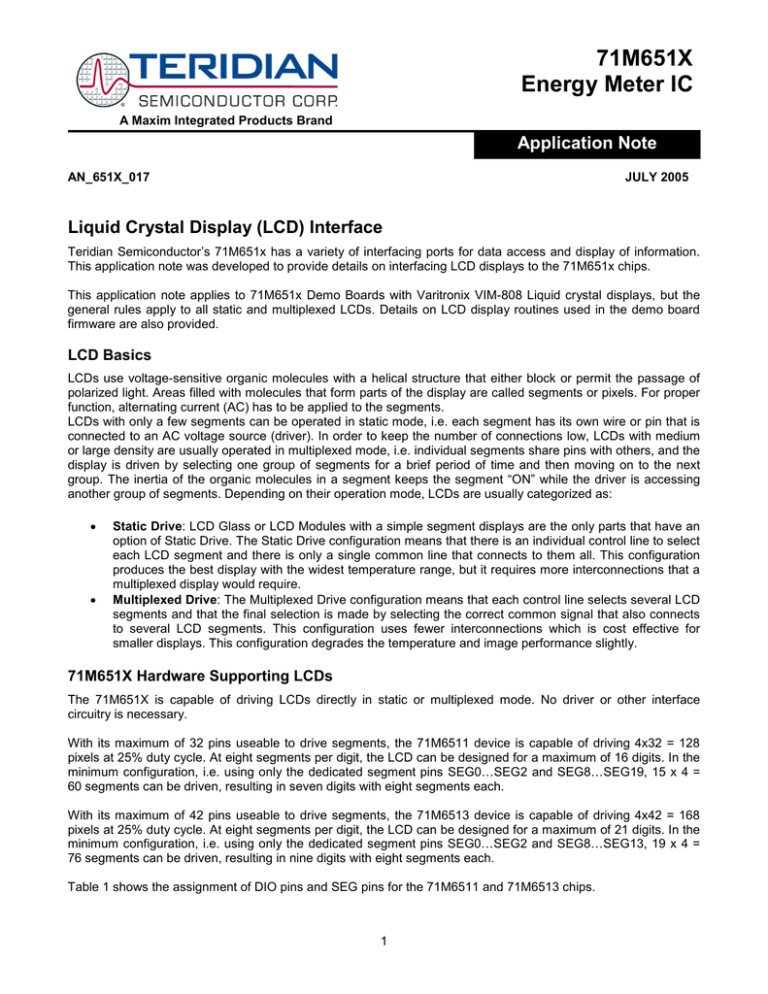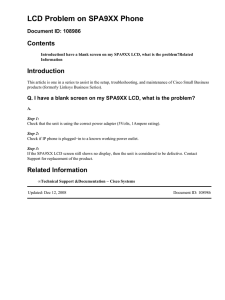
71M651X
Energy Meter IC
A Maxim Integrated Products Brand
Application Note
AN_651X_017
JULY 2005
Liquid Crystal Display (LCD) Interface
Teridian Semiconductor’s 71M651x has a variety of interfacing ports for data access and display of information.
This application note was developed to provide details on interfacing LCD displays to the 71M651x chips.
This application note applies to 71M651x Demo Boards with Varitronix VIM-808 Liquid crystal displays, but the
general rules apply to all static and multiplexed LCDs. Details on LCD display routines used in the demo board
firmware are also provided.
LCD Basics
LCDs use voltage-sensitive organic molecules with a helical structure that either block or permit the passage of
polarized light. Areas filled with molecules that form parts of the display are called segments or pixels. For proper
function, alternating current (AC) has to be applied to the segments.
LCDs with only a few segments can be operated in static mode, i.e. each segment has its own wire or pin that is
connected to an AC voltage source (driver). In order to keep the number of connections low, LCDs with medium
or large density are usually operated in multiplexed mode, i.e. individual segments share pins with others, and the
display is driven by selecting one group of segments for a brief period of time and then moving on to the next
group. The inertia of the organic molecules in a segment keeps the segment “ON” while the driver is accessing
another group of segments. Depending on their operation mode, LCDs are usually categorized as:
•
•
Static Drive: LCD Glass or LCD Modules with a simple segment displays are the only parts that have an
option of Static Drive. The Static Drive configuration means that there is an individual control line to select
each LCD segment and there is only a single common line that connects to them all. This configuration
produces the best display with the widest temperature range, but it requires more interconnections that a
multiplexed display would require.
Multiplexed Drive: The Multiplexed Drive configuration means that each control line selects several LCD
segments and that the final selection is made by selecting the correct common signal that also connects
to several LCD segments. This configuration uses fewer interconnections which is cost effective for
smaller displays. This configuration degrades the temperature and image performance slightly.
71M651X Hardware Supporting LCDs
The 71M651X is capable of driving LCDs directly in static or multiplexed mode. No driver or other interface
circuitry is necessary.
With its maximum of 32 pins useable to drive segments, the 71M6511 device is capable of driving 4x32 = 128
pixels at 25% duty cycle. At eight segments per digit, the LCD can be designed for a maximum of 16 digits. In the
minimum configuration, i.e. using only the dedicated segment pins SEG0…SEG2 and SEG8…SEG19, 15 x 4 =
60 segments can be driven, resulting in seven digits with eight segments each.
With its maximum of 42 pins useable to drive segments, the 71M6513 device is capable of driving 4x42 = 168
pixels at 25% duty cycle. At eight segments per digit, the LCD can be designed for a maximum of 21 digits. In the
minimum configuration, i.e. using only the dedicated segment pins SEG0…SEG2 and SEG8…SEG13, 19 x 4 =
76 segments can be driven, resulting in nine digits with eight segments each.
Table 1 shows the assignment of DIO pins and SEG pins for the 71M6511 and 71M6513 chips.
1
AN_651X_017
DIO
Pin
DIO21
DIO20
DIO19
DIO18
DIO17
DIO16
DIO15
DIO14
DIO13
DIO12
DIO11
DIO10
DIO9
DIO8
DIO7
DIO6
DIO5
DIO4
Segment
Pin
SEG41
SEG40
SEG39
SEG38
SEG37
SEG36
SEG35
SEG34
SEG33
SEG32
SEG31
SEG30
SEG29
SEG28
SEG27
SEG26
SEG25
SEG24
SEG23
SEG22
SEG21
SEG20
LCD Interface for TERIDIAN 71M651X
Alternate
Function
VARPULSE
WPULSE
SDATA
SCLK
Availability
6511 6513
X
X
X
X
X
X
X
X
X
X
X
X
X
X
X
X
X
X
X
X
X
X
X
X
X
X
X
X
X
X
X
X
X
X
DIO
Pin
Segment
Pin
SEG19
SEG18
SEG17
SEG16
SEG15
SEG14
SEG13
SEG12
SEG11
SEG10
SEG9
SEG8
SEG7
SEG6
SEG5
SEG4
SEG3
SEG2
SEG1
SEG0
Alternate
Function
MUX_SYNC
SRDY
SFR
SSDATA
SCLK
TEST2
TEST1
TEST0
DIO3
DIO2
DIO1
DIO0
Availability
6511 6513
X
X
X
X
X
X
X
X
X
X
X
X
X
X
X
X
X
X
X
X
X
X
X
X
X
X
X
X
X
X
X
X
X
X
X
X
X
X
X
X
X
X
X
X
Table 1: DIO/SEG Map
The LCD driver circuitry is grouped into 4 common outputs (COM0 to COM3) and up to 42 segment outputs. The
COM0 through COM3 outputs are more than logical outputs, since they generate wave forms that, in conjunction
with the wave forms generated by the SEG outputs, combine to true AC signals supplied to each individual
segment. This means that the COM voltage is below the SEG voltage for some periods of time and above the
SEG voltage for other periods of time.
The voltage present at the VLCD input is used internally by the chip to generate the LCD drive signals. A charge
pump suitable for driving VLCD is included on-chip. This circuit creates 5VDC from the 3.3VDC supply using an
external capacitor and diode network connected to the VDRV output (see Figure 1). This feature can be enabled
with the LCD_BSTEN register.
V3P3
VDRV
5VDC
651X
5V LCD
VLCD
segments
commons
Figure 1: LCD Boost Circuit
2
AN_651X_017
LCD Interface for TERIDIAN 71M651X
71M651X Segment and LCD Control Registers
LCD operation is configured and controlled by registers in the configuration memory (I/O RAM). Configuration
memory starts at physical address 0x2000, and access to all registers is possible using the serial interface ( >RI
command).
MPU firmware can easily reconfigure the LCD and change displayed information by writing to the LCD control
registers.
LCD Mode
When configuring the LCD, the first parameter that has to be defined is the LCD operation mode, using the
LCD_MODE register. The operation mode depends on the type of the LCD that is used with the 71M651X chip.
For the 651X Demo Boards, the operation mode is 001, or 3-states, 1/3 bias. A maximum of four states to a
minimum of one state (for static display) can be configured.
Register Name
Address [bits]
R/W
Description
LCD_MODE[2:0]
2021[4:2]
R/W
The LCD bias mode.
000: 4 states, 1/3 bias
001: 3 states, 1/3 bias
010: 2 states, ½ bias
011: 3 states, ½ bias
100: static display
LCD Operating Voltage
The type of LCD used for a particular implementation will determine whether 3.3VDC or 5VDC will be used for
driving the LCD. As explained in the previous section, the 71M651X provides a charge pump capable of boosting
the 3.3VDC supply voltage up to 5.0VDC. The boost circuit is enabled with the LCD_BSTEN register. The 651X
Demo Boards have the boost circuit enabled by default.
Register Name
Address [bits]
R/W
Description
LCD_BSTEN
2020[7]
R/W
Enables the LCD voltage boost circuit.
LCD Clock
The next parameter to be configured is the LCD clock using the LCD_CLK register. This is the frequency at which
the COM pins change states. A slower clock means lower power consumption, but if the clock is too slow, visible
flicker can occur. The default clock frequency for the 71M651X Demo Boards is 150Hz (LCD_CLK = 01).
Register Name
Address [bits]
R/W
Description
LCD_CLK[1:0]
2021[1:0]
R/W
Sets the LCD clock frequency, i.e. the frequency at which
SEG and COM pins change states.
Note: fw = CKADC/128 = 38,400
9
8
7
6
00: fw/2 , 01: fw/2 , 10: fw/2 , 11: fw/2
LCD Control Registers
The display outputs are enabled by setting the LCD_EN register to 1.
Register Name
Address [bits]
R/W
Description
LCD_EN
2021[5]
R/W
Enables the LCD display. When disabled, VLC2, VLC1,
and VLC0 are ground as are the COM and SEG outputs.
3
AN_651X_017
LCD Interface for TERIDIAN 71M651X
Depending on the hardware configuration surrounding the 71M651X chip, more or less dual-purpose I/O pins are
used for display. By writing a value of 1 through 18 to the LCD_NUM register, the number of segment pins used
for display is determined.
Register Name
Address [bits]
R/W
Description
LCD_NUM[4:0]
2020[4:0]
R/W
Number of dual-purpose LCD/DIO pins to be configured as
LCD outputs. This will be a number between 0 and 18.
The first dual-purpose pin to be allocated as LCD is
SEG41/DIO21. Thus, if LCD_NUM=2, SEG41 and SEG 40
will be configured as LCD. The remaining SEG39 to
SEG24 will be configured as DIO19 to DIO4.
The first dual-purpose pin to be allocated as LCD is SEG37/DIO17. Tables 2 (71M6511) and 3 (71M6513) below
list the achievable combination of SEG and DIO pins as a function of the LCD_NUM value.
71M6511
LCD_NUM
1-4
LCD Segments
Available
DIO Pins Available
None
DIO4-11, DIO14-17
5
SEG37
DIO4-11, DIO14-16
6
SEG36-37
DIO4-11, DIO14-15
7
SEG35-37
DIO4-11, DIO14
8-10
SEG34-37
DIO4-11
11
SEG34-37, SEG31
DIO4-10
12
SEG34-37, SEG30-31
DIO4-9
13
SEG34-37, SEG29-31
DIO4-8
14
SEG34-37, SEG28-31
DIO4-7
15
SEG34-37, SEG27-31
DIO4-6
16
SEG34-37, SEG26-31
DIO4-5
17
SEG34-37, SEG25-31
DIO4
18
SEG34-37, SEG24-31
None
Table 2: LCD_NUM Controlling SEG and DIO (6511)
4
AN_651X_017
LCD Interface for TERIDIAN 71M651X
6513
LCD_NUM
LCD Segments
Available
DIO Pins Available
0
SEG0-23
DIO0-3, DIO4-21
1
SEG0-23, SEG41
DIO0-3, DIO4-20
2
SEG0-23, SEG40-41
DIO0-3, DIO4-19
3
SEG0-23, SEG39-41
DIO0-3, DIO4-18
4
SEG0-23, SEG38-41
DIO0-3, DIO4-17
5
SEG0-23, SEG37-41
DIO0-3, DIO4-16
6
SEG0-23, SEG36-41
DIO0-3, DIO4-15
7
SEG0-23, SEG35-41
DIO0-3, DIO4-14
8
SEG0-23, SEG34-41
DIO0-3, DIO4-13
9
SEG0-23, SEG33-41
DIO0-3, DIO4-12
10
SEG0-23, SEG32-41
DIO0-3, DIO4-11
11
SEG0-23, SEG31-41
DIO0-3, DIO4-10
12
SEG0-23, SEG30-41
DIO0-3, DIO4-9
13
SEG0-23, SEG29-41
DIO0-3, DIO4-8
14
SEG0-23, SEG28-41
DIO0-3, DIO4-7
15
SEG0-23, SEG27-41
DIO0-3, DIO4-6
16
SEG0-23, SEG26-41
DIO0-3, DIO4-5
17
SEG0-23, SEG25-41
DIO0-3, DIO4
18
SEG0-41
DIO0-3
Table 3: LCD_NUM Controlling SEG and DIO (6513)
The contrast of the LCD can be controlled with the LCD_FS register. Values from 00 to 0x1F can be written to this
register causing the VLCD voltage to be adjusted with an on-chip DAC from 70% of VLCD to 100% of VLCD.
Register Name
Address [bits]
R/W
Description
LCD_FS[4:0]
2022[4:0]
R/W
Controls the LCD full scale voltage, VLC2:
VLC 2 = VLCD ⋅ (0.7 + 0.3
LCD _ FS
)
31
Finally, the individual segments of the LCD have to be controlled. Since each pixel is addressed individually, the
LCD display can be a combination of alphanumeric digits and custom enunciator symbols. The data for the
segments is placed into the registers LCD_SEG0 through LCD_SEG41.
Writing the datum 0x06 into address 0x2030 will activate the corresponding segments when COM0 and COM1
outputs are active if the display is operated in two or three-state mode.
Register Name
Address [bits]
R/W
Description
LCD_SEG0[3:0]
…
LCD_SEG41[3:0]
2030[3:0]
…
2059[3:0]
R/W
LCD Segment Data. Each word contains information for 1
to 4 time divisions of each segment. In each word, bit 0
corresponds to COM0, on up to bit 3 for COM3.
5
AN_651X_017
LCD Interface for TERIDIAN 71M651X
LCD Signals
Figure 2 shows typical LCD waveforms for four states at 1/3 bias for one frame of data. The voltage levels for V1,
V2 and V3 depend on the voltage applied to the VLCD input pin. Assuming that 5V are supplied to VLCD (with
voltage boost enabled and LCD_FS set to 31), the resulting amplitudes for V1, V2 and V3 will be 1.66, 3.33 and
5.0V.
FRAME
LCD Clock
DATA
V1
V2
V3
Vss
V1
V2
V3
Vss
V1
V2
V3
Vss
COM0
COM1
COM2
V1
V2
V3
Vss
V1
V2
V3
Vss
COM3
SEGx
Figure 2: LCD Wave Forms
In Figure 2, the data for segment X changes from 1 to zero in the middle of the frame.
The LCD Module Used on the Demo Board
The Varitronix VIM-808 module is used for both the 6511 and 6513 Demo Boards. This LCD module has three
common pins and provides eight digits consisting of seven segments, including decimal points for each digit and
three colons located at digits 2, 4, and 6. The colons can be used for time display, e.g. “12:55:42”. Figure 3 shows
the layout of the VIM-808 (digit numbers are shown above the segments).
8
7
6
5
4
3
Figure 3: VIM-808 Top View
6
2
1
AN_651X_017
LCD Interface for TERIDIAN 71M651X
Figure 3 also shows the location of the connection pins for the VIM-808. Figure 4 shows a segment/pixel map for
one digit. Note that only digits 2, 4, and 6 have the L segments forming the colon, and that the colon segments
are connected to the 71M651X chip only on the 6513 Demo board.
A
F
B
L
G
L
E
C
D
DP
Figure 4: Segment Definitions
The pin-out map for the VIM-808 is shown in table 4. Twelve pins are not connected to any segment (NC). For
example, pin 1 controls segments/pixels B and C of digit 8 plus the decimal point of digit 7.
Pin No.
Segment
Pin No.
Segment
Pin No.
Segment
1
8B, 8C, 7DP
15
3B, 3C, 2DP
29
3F, 3E, NC
2
NC
16
NC
30
4A, 4G, 4D
3
7B, 7C, 6DP
17
NC
31
4F, 4E, NC
4
NC
18
2B, 2C, 1DP
32
NC, NC, 4L
5
NC
19
NC
33
5A, 5G, 5D
6
6B, 6C, 5DP
20
1B, 1C, NC
34
5F, 5E, NC
7
NC
21
COM 3
35
6A, 6G, 6D
8
NC
22
COM 1
36
6F, 6E, NC
9
5B, 5C, 4DP
23
1A, 1G, 1D
37
NC, NC, 6L
10
NC
24
1F, 1E, NC
38
7A, 7G, 7D
11
NC
25
2A, 2G, 2D
39
7F, 7E, NC
12
4B, 4C, 3DP
26
2F, 2E, NC
40
8A, 8G, 8D
13
NC
27
NC, NC, 2L
41
8F, 8E, NC
14
NC
28
3A, 3G, 3D
42
COM 2
Table 4: VIM-808 Pin Map
The electrical connections implemented on the Demo Boards along with the VIM-808 pin map combine to the
connection map shown in table 5. This table shows which LCD output pin on the 6511 is connected to which pin
of the LCD. The NC pins from table 5 are not shown in Table 4.
7
AN_651X_017
LCD Interface for TERIDIAN 71M651X
VIM-808
LCD pin
I/O
Address
Connected to
Affected Segments
6511 Pin
6513 Pin
COM1
COM2
COM3
1
2030
SEG00
SEG00
8B
8C
7DP
3
2031
SEG 01
SEG 01
7B
7C
6DP
6
2032
SEG 02
SEG 02
6B
6C
5DP
9
2033
SEG 03
SEG 03
5B
5C
4DP
12
2034
SEG 04
SEG 04
4B
4C
3DP
15
2035
SEG 05
SEG 05
3B
3C
2DP
18
2036
SEG 06
SEG 06
2B
2C
1DP
20
2037
SEG 07
SEG 07
1B
1C
--
21 (COM3)
--
COM2
COM2
--
--
--
22 (COM1)
--
COM0
COM0
--
--
--
23
204C
SEG 28
SEG 28
1A
1G
1D
24
204D
SEG 29
SEG 29
1F
1E
25
204E
SEG 30
SEG 30
2A
2G
26
204F
SEG 31
SEG 31
2F
2E
27
--
--
SEG32
--
--
2L
28
2038
SEG 08
SEG 08
3A
3G
3D
29
2039
SEG 09
SEG 09
3F
3E
--
30
203A
SEG 10
SEG 10
4A
4G
4D
31
203B
SEG 11
SEG 11
4F
4E
--
32
--
--
SEG32
--
--
4L
33
203C
SEG 12
SEG 12
5A
5G
5D
34
203D
SEG 13
SEG 13
5F
5E
--
35
203E
SEG 14
SEG 14
6A
6G
6D
36
203F
SEG 15
SEG 15
6F
6E
--
37
--
--
SEG35
--
--
6L
38
2040
SEG 16
SEG 16
7A
7G
7D
39
2041
SEG 17
SEG 17
7F
7E
--
40
2042
SEG 18
SEG 18
8A
8G
8D
41
2043
SEG 19
SEG 19
8F
8E
--
42 (COM2)
--
COM1
COM1
--
--
--
Table 5: 651X LCD Pin/Segment Map
8
2D
AN_651X_017
LCD Interface for TERIDIAN 71M651X
LCD Mapping
Figure 5 shows the physical mapping of the COM signals to the segments of the VIM-808 LCD.
COM3
COM1
COM2
Figure 5: Physical Mapping of COM Signals
9
AN_651X_017
LCD Interface for TERIDIAN 71M651X
Supporting Firmware Routines
LCD Data Declarations for VIM-808 LCD:
#define COM(x) (x << 6)
enum COMMONS { COM0 = COM(0), COM1 = COM(1), COM2 = COM(2) };
enum SEGS
{
//COM0
SEG_8B
SEG_4B
SEG_3A
SEG_5A
SEG_7A
SEG_1A
SEGMENTS
= COM0 | 0,
= COM0 | 4,
= COM0 | 8,
= COM0 |12,
= COM0 |16,
= COM0 |28,
SEG_7B
SEG_3B
SEG_3F
SEG_5F
SEG_7F
SEG_1F
=
=
=
=
=
=
COM0
COM0
COM0
COM0
COM0
COM0
| 1,
| 5,
| 9,
|13,
|17,
|29,
SEG_6B
SEG_2B
SEG_4A
SEG_6A
SEG_8A
SEG_2A
=
=
=
=
=
=
COM0
COM0
COM0
COM0
COM0
COM0
| 2,
| 6,
|10,
|14,
|18,
|30,
SEG_5B
SEG_1B
SEG_4F
SEG_6F
SEG_8F
SEG_2F
=
=
=
=
=
=
COM0
COM0
COM0
COM0
COM0
COM0
| 3,
| 7,
|11,
|15,
|19,
|31,
//COM1
SEG_8C
SEG_4C
SEG_3G
SEG_5G
SEG_7G
SEG_1G
SEGMENTS
= COM1 | 0,
= COM1 | 4,
= COM1 | 8,
= COM1 |12,
= COM1 |16,
= COM1 |28,
SEG_7C
SEG_3C
SEG_3E
SEG_5E
SEG_7E
SEG_1E
=
=
=
=
=
=
COM1
COM1
COM1
COM1
COM1
COM1
| 1,
| 5,
| 9,
|13,
|17,
|29,
SEG_6C
SEG_2C
SEG_4G
SEG_6G
SEG_8G
SEG_2G
=
=
=
=
=
=
COM1
COM1
COM1
COM1
COM1
COM1
| 2,
| 6,
|10,
|14,
|18,
|30,
SEG_5C
SEG_1C
SEG_4E
SEG_6E
SEG_8E
SEG_2E
=
=
=
=
=
=
COM1
COM1
COM1
COM1
COM1
COM1
| 3,
| 7,
|11,
|15,
|19,
|31,
SEG_6DP=
SEG_2DP=
SEG_4D =
SEG_8D =
SEG_4L =
COM2
COM2
COM2
COM2
COM2
| 1,
| 5,
|10,
|18,
|33,
SEG_5DP=
SEG_1DP=
SEG_5D =
SEG_1D =
SEG_6L =
COM2
COM2
COM2
COM2
COM2
| 2, SEG_4DP= COM2 | 3,
| 6,
|12, SEG_6D = COM2 |14,
|28, SEG_2D = COM2 |30,
|34
};
// List all segments of display in com/segment order.
//COM2 SEGMENTS
SEG_7DP= COM2 | 0,
SEG_3DP= COM2 | 4,
SEG_3D = COM2 | 8,
SEG_7D = COM2 |16,
SEG_2L = COM2 |32,
// List all segments of all LCD icons.
enum SEGS code Digit_1[] =
// 1st digit.
{ SEG_1A, SEG_1B, SEG_1C, SEG_1D, SEG_1E, SEG_1F, SEG_1G };
enum SEGS code Digit_2[] =
// 2nd digit.
{ SEG_2A, SEG_2B, SEG_2C, SEG_2D, SEG_2E, SEG_2F, SEG_2G };
enum SEGS code Digit_3[] =
// 3rd digit.
{ SEG_3A, SEG_3B, SEG_3C, SEG_3D, SEG_3E, SEG_3F, SEG_3G };
enum SEGS code Digit_4[] =
// 4th digit.
{ SEG_4A, SEG_4B, SEG_4C, SEG_4D, SEG_4E, SEG_4F, SEG_4G };
enum SEGS code Digit_5[] =
// 5th digit.
{ SEG_5A, SEG_5B, SEG_5C, SEG_5D, SEG_5E, SEG_5F, SEG_5G };
enum SEGS code Digit_6[] =
// 6th digit.
{ SEG_6A, SEG_6B, SEG_6C, SEG_6D, SEG_6E, SEG_6F, SEG_6G };
enum SEGS code Digit_7[] =
// 7th digit.
{ SEG_7A, SEG_7B, SEG_7C, SEG_7D, SEG_7E, SEG_7F, SEG_7G };
enum SEGS code Digit_8[] =
// 8th digit.
{ SEG_8A, SEG_8B, SEG_8C, SEG_8D, SEG_8E, SEG_8F, SEG_8G };
enum SEGS code Icon_DP[] =
// Decimal points.
{ SEG_1DP, SEG_2DP, SEG_3DP, SEG_4DP, SEG_5DP, SEG_6DP, SEG_7DP };
enum SEGS code Icon_L[] =
{ SEG_2L, SEG_4L, SEG_6L };
// Colons ':'.
U08 code * code icons[] =
{
Digit_1, Digit_2, Digit_3, Digit_4,
Digit_5, Digit_6, Digit_7, Digit_8,
Icon_DP, Icon_L
};
10
AN_651X_017
LCD Interface for TERIDIAN 71M651X
// Number of segments
U08 code num_segs[] =
{
sizeof (Digit_1),
sizeof (Digit_5),
sizeof (Icon_DP),
};
in each icon.
sizeof (Digit_2), sizeof (Digit_3), sizeof (Digit_4),
sizeof (Digit_6), sizeof (Digit_7), sizeof (Digit_8),
sizeof (Icon_L)
The demo code low-level libraries provide the following functions for controlling the LCD:
Initialization, Configuration, Read, and Write Routines
/***************************************************************************
* This code and information is provided "as is" without warranty of any
*
* kind, either expressed or implied, including but not limited to the
*
* implied warranties of merchantability and/or fitness for a particular
*
* purpose.
*
*
*
* Copyright (C) 2003 TERIDIAN SemiConductor, Corporation. All Rights Reserved. *
*
*
***************************************************************************/
//**************************************************************************
//
// DESCRIPTION: 71M651x POWER METER - LCD Routines.
//
//**************************************************************************
//
// File: LCD.C
//
#include "options.h"
#include "api.h"
#define
#define
#define
#define
LCD_SEG_COM0
LCD_SEG_COM1
LCD_SEG_COM2
LCD_SEG_COM3
/*
+-----a-----+
|
|
|
|
f
b
|
|
|
|
+-----g-----+
|
|
|
|
e
c
|
|
|
|
+-----d-----+
*/
BIT0
BIT1
BIT2
BIT3
//
//
//
//
LCD
LCD
LCD
LCD
Segment
Segment
Segment
Segment
Data
Data
Data
Data
COM0.
COM1.
COM2.
COM3.
Mapping of character to digit/elements.
Bitmapped Mask
'0'
'1'
'2'
'3'
'4'
'5'
'6'
'7'
'8'
'9'
-,-,f,e,
-,-,-,-,
-,g,-,e,
-,g,-,-,
-,g,f,-,
-,g,f,-,
-,g,f,e,
-,-,-,-,
-,g,f,e,
-,g,f,-,
d,c,b,a
-,c,b,d,-,b,a
d,c,b,a
-,c,b,d,c,-,a
d,c,-,-,c,b,a
d,c,b,a
-,c,b,a
/*** External functions used within this module ***/
// None
/*** External variables used within this module ***/
extern U08r * code icons[];
// Defined by user application.
extern U08r num_segs[];
//
extern U16r idx2bit[];
/*** Public functions declared within this module ***/
// LCD API.
//
void LCD_Init (void);
void LCD_Command (U08 LcdCmd);
11
AN_651X_017
LCD Interface for TERIDIAN 71M651X
void LCD_Config (U01 boost, U08 num, enum LCD_BIAS bias, enum LCD_CLK clock, U08
voltage);
U16 LCD_Data_Read (U08 Icon);
void LCD_Data_Write (U08 icon, U16 Mask);
//***************************************************************************
// LCD_Command (LCD_CLEAR);
Clear display.
// LCD_Command (LCD_DISPLAY_ON); Display ON.
// LCD_Command (LCD_DISPLAY_OFF); Display OFF.
//***************************************************************************
#define LCD_CLEAR
0x01
#define LCD_DISPLAY_ON 0x0C
#define LCD_DISPLAY_OFF 0x08
// Clears Entire LCD.
// Display ON.
// Display OFF.
/*** Public variables declared within this module ***/
// None.
/*** Private functions declared within this module ***/
static void lcd_clear (void);
static void lcd_ctrl (U08 ctrl);
/*** Private variables used within this module ***/
#define SEGMENT_MASK 0x3F
// Number of SEGMENT drivers.
#define COM_MASK
~SEGMENT_MASK
// Number of COMMONs.
#define COM_ALIGN
6
static U08r com2bit[] = { LCD_SEG_COM0, LCD_SEG_COM1, LCD_SEG_COM2, LCD_SEG_COM3 };
// LCD API.
//
void LCD_Init (void)
{
LCD_Command (LCD_CLEAR);
LCD_Command (LCD_DISPLAY_ON );
}
// This routine should be called on power-up
// Display Cleared.
// Display ON.
void LCD_Command (U08 LcdCmd)
{
if (LcdCmd & LCD_CLEAR)
lcd_clear ();
else
lcd_ctrl (LcdCmd);
}
U16 LCD_Data_Read (U08 Icon)
{
// Handle up to 16 segments per icon.
U08 code *seg;
U08 xdata i, xdata common, xdata seg_drv;
U16 Value = 0;
// Assume no active seqments.
seg = icons[ Icon ];
for (i = 0; i < num_segs[ Icon ]; i++)
{
seg_drv = *seg & SEGMENT_MASK;
common = com2bit[ *seg >> COM_ALIGN ];
if (LCD_SEG[ seg_drv ] & common)
Value |= idx2bit[ i ];
seg++;
}
return (Value);
}
12
// Segment is active.
AN_651X_017
LCD Interface for TERIDIAN 71M651X
void LCD_Data_Write (U08 Icon, U16 Mask)
{
// Handle upto 16 segments per icon.
U08 code *seg;
U08 xdata i, xdata common, xdata seg_drv;
seg = icons[ Icon ];
for (i = 0; i < num_segs[ Icon ]; i++)
{
seg_drv = *seg & SEGMENT_MASK;
common = com2bit[ *seg >> COM_ALIGN ];
if (Mask & 1)
LCD_SEG[ seg_drv ] |= common;
else
LCD_SEG[ seg_drv ] &= ~common;
}
// Activate segment.
// DeActivate segment.
seg++;
Mask >>= 1;
}
void LCD_Config (U01 boost, U08 num, enum LCD_BIAS bias, enum LCD_CLK clock, U08
voltage)
{
LCDX = (boost << 7) | num;
LCDY = (LCDY & ~(LCD_MODE | LCD_CLK_)) | (bias << 2) | clock;
LCDZ = (LCDZ & ~LCD_FS) | voltage;
}
static void lcd_clear (void)
{
memset_x (LCD_SEG, 0, sizeof (LCD_SEG));
}
static void lcd_ctrl (U08 ctrl)
{
if (LCD_DISPLAY_ON == ctrl)
LCDY |= LCD_EN;
else
LCDY &= ~LCD_EN;
}
13
AN_651X_017
LCD Interface for TERIDIAN 71M651X
Maxim cannot assume responsibility for use of any circuitry other than circuitry entirely embodied in a Maxim product. No circuit patent
licenses are implied. Maxim reserves the right to change the circuitry and specifications without notice at any time.
Maxim Integrated Products, 120 San Gabriel Drive, Sunnyvale, CA 94086 408- 737-7600
2010 Maxim Integrated Products
Maxim is a registered trademark of Maxim Integrated Products.







